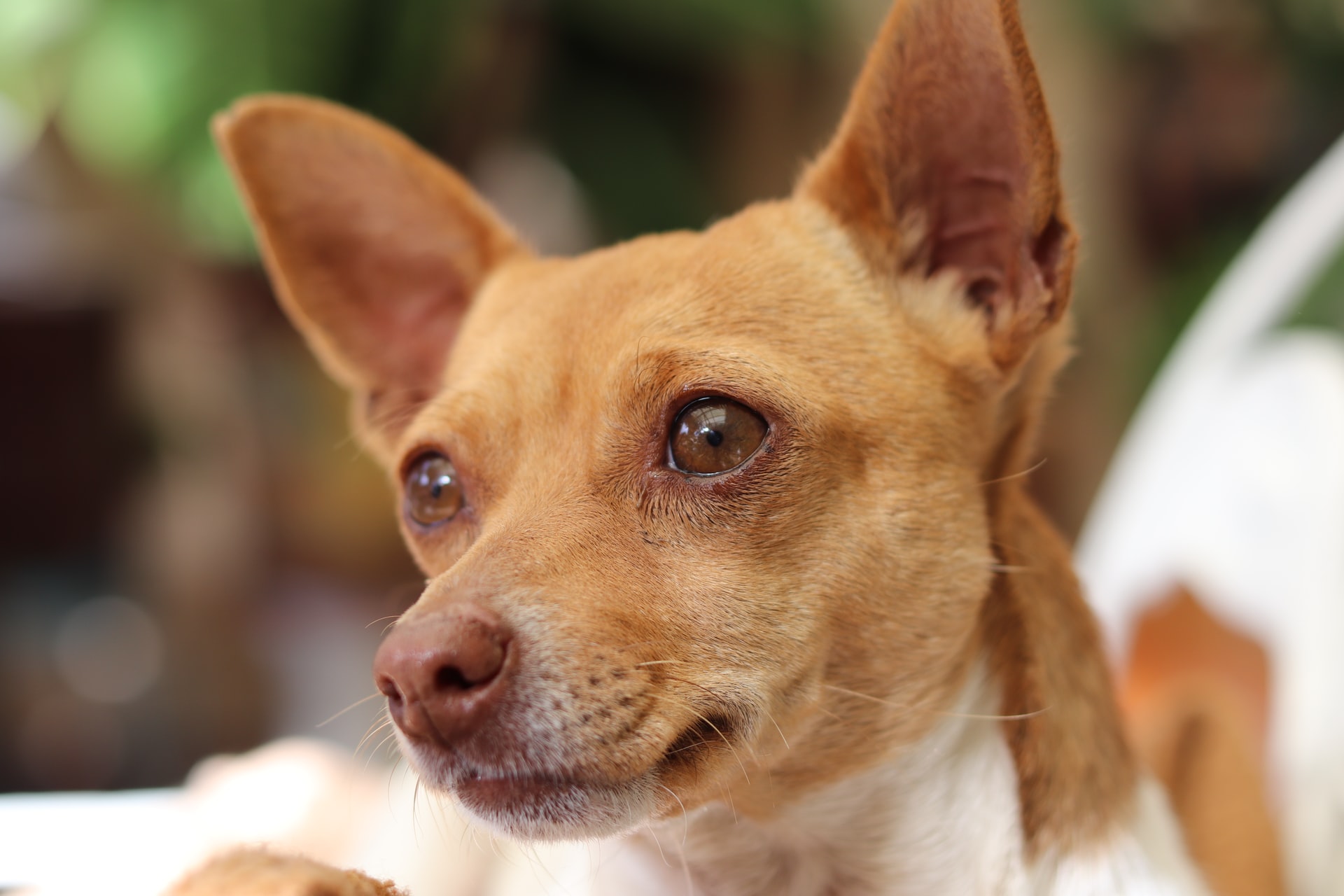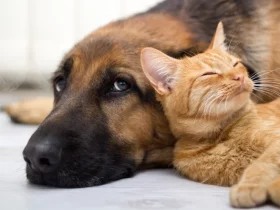Mating, while a perfectly natural action, is not always as simple as you would think. Inexperienced dogs, most often the male, have difficulty in consummating the sexual act. True, most males readily mount a female and go through the motions of the sexual act, but they fail to penetrate the female. On the other hand, nervous bitches may make it difficult for the male to copulate. They may refuse to stand for the male or they snap at him, thus not only making things difficult, but discouraging him. These are some of the complications of mating.
Before we discuss the actual mating process, some information on the sexual behavior of the male and female is in order.
The male dog
The male is more or less sexually active all year round. His interest in sex starts early in puppyhood. Pups as young as three months old show sexual interest. They will mount your leg or the backs of their litter mates. These sexual actions on the part of the male pup don’t necessarily mean that he’s oversexed or showing abnormal behavior. These may come later on, when he’s mature and cannot get rid of his is sexual energy. Early mounting and interest in sex are instinctive reactions. Nature is preparing the pup for his future role of procreator.
As the pup matures he will show more and more sexual interest. The desire to mate increases with age. The awkward pup will show more interest in other dogs, both male and female. He’ll carefully examine their genitals and mount them, going through the motions of the sexual act. Most of the time this mounting and simulating the sexual act is nothing more than a “dry run.” The young male is usually too inexperienced to actually copulate. Believe it or not, he will probably need some help to achieve a complete mating.
Unless the male is kept under control, his increasing interest in sex can get him into trouble. Sex and food are two topics guaranteed to start a dog fight. Nowadays, most dogs are well fed and don’t often get into a fight over food. Not so with sex. Just let a female in heat go by and she will quickly have a large following of males, ranging from pups to grizzled veterans. The competition for her favors becomes fierce and fights break out. Usually the best fighter does all of the mating, or at least gets the first chance.
This sexual competition among males is another one of Nature’s plans to perpetuate a strong species. The weak and ineffectual males are weeded out in the fights. Only the strong get a chance to mate in the wild dog packs; the weak ones have to be content with the role of onlooker.
But the survival of the fittest is not an issue among domestic dogs. You are not interested in having your male eliminated. Nor do you want him to be injured. And he can get injured if he tangles with huskier and more sagacious dogs while competing for a female. All of this is a good reason why you should keep your dog at home.
T he average mature male getting a balanced diet and adequate exercise is capable of mating up to the time he is 10 to 12 years old. He should not be mated under 1 year of age in or over 10 years. The American Kennel Club will not accept puppies for registration when the sire is under 7 months of age or over 12 years. The over-1-year and under-1 o-year regime is best to follow.
Cryptorchidism
Cryptorchidism among dogs is not uncommon. It is a condition in which both testicles have not descended from the body into the scrotum. Cryptorchids are sterile. They cannot breed since the undescended testicles are either atrophied or the spermatozoa are killed or rendered immobile by the body heat.
Monorchidism
Occasionally, you will see a dog that has only one descended testicle. Monorchids are not sterile. They can mate and produce offspring just as well as the dog with two testicles. But the condition is a fault. Geneticists believe that monorchidism is hereditary; consequently, if you have a male with one testicle, your chances of mating him to a purebred bitch are nil. There is too good a chance that a portion of any litter sired by a monorchid will inherit the fault.
The female dog
The female or bitch comes into heat twice a year. Like the young male pup, the female will show sexual interest at an early age. She will indulge in juvenile sex play, perhaps even mounting her litter mates or examining the genitals of both males and females. Later, as she matures, she will grow out of this juvenile sexual behavior and settle down to a rhythmic pattern of coming into heat twice a year. She will restrict her sexual interest to the heat periods.
You will recall that the bitch’s heat period is divided into phases. During the first phase, you will notice that her vulva or external genitals are swollen. The bitch will pay attention to this swelling by constantly licking the parts. She may also be slightly nervous or uneasy. Her appetite will vary from day to day; in fact, as her heat cycle increases, she may skip a meal or two. Males will be interested in the bitch during the first phase, but she will not encourage them. Most likely she’ll do the opposite; discourage them by snapping or growling at them.
There is no need to be concerned that the bitch might be hurt by males when she acts like this. No matter how fiercely she resists the advances of eager males, they will not retaliate. No male will ever attack or bite a female—in or out of heat— unless he is berserk or rabid. This is the law of the pack and no male in his right mind ever violates it.
At the end of the first week after the vulva have become swollen, the second phase starts. This is characterized by a discharge. The discharge is bright red at first, later changing to a pinkish fluid (or colorless fluid) five to nine days after the discharge starts. With rare exceptions, the bitch will attend to the matter of cleaning herself and her bed. But there is always the possibility that she will stain rugs, carpets and furniture. It’s best to keep her in a place that is easily cleaned during her heat period, especially during the discharge phase. There are special sanibelts for bitchs, available in pet stores, but these irk the dog and are more bother than worth.
Toward the end of the second phase, the bitch becomes very coy and playful. She will be very solicitous to all males. But she is still not ready to stand and be mated. Then; is some risk though; some overzealous and impatient male may corner and mount her. And since conception may take place, keep her confined if you don’t want her mated or are planning to mate her with a particular dog.
The discharge ceases at the beginning of the third phase
The bitch is now ready for mating, usually between the 9th and 14th days from the onset of the heat period. Conception has its best chance between the 11th and 14th days, with the 12th and 13th days considered as the optimum. During the third phase, the bitch will encourage all males and will stand to be mated, thrusting her tail aside. Here, again, you will have to keep a close watch on her if you don’t want to mate or wish to avoid a mismating. The urge to mate will be very strong at this time and the bitch will make every effort to get out.
A bitch can be very troublesome when she’s ready to mate. Taking her for walks on a leash can be hazardous. You’ll have to be constantly on the lookout for males. They will not be far away; “word” gets around very quickly that there’s a bitch in heat in the neighborhood! Despite your efforts, a male can be on top of the bitch before you know it. And 63 days later, you’ll be the owner of some puppies.
Young bitches should not be mated before their second heat period; larger breeds should be allowed to reach the third heat period. Saint Bernards and Irish Wolfhounds are examples of large breeds that should be permitted to attain maximum growth before being mated. These and other very large breeds are slow to mature. The American Kennel Club will not accept puppies for registration from a bitch that is under 8 months or over 12 years of age. But even though a bitch may be capable of breeding up to her 12th year, it’s best to stop breeding her when she’s 7 or 8 years old.
Spaying
If you decide you do not want to mate your bitch, you can have her spayed. Spaying is an operation in which the bitch’s ovaries are removed. This eliminates the heat periods and the possibility of conception. In the hands of a competent veterinarian, the operation is a simple one.
Spaying is a form of birth control among dogs. When you consider the large number of stray and unwanted dogs in this country, you’ll agree that some form of control is necessary. There have been some arguments advanced against spaying; some of them on moral principles, some on physical grounds. They range from the argument that spaying interferes with Nature to the argument that spaying makes a dog fat and lazy.
Concerning the argument that spaying interferes with Nature, we’ll leave that to the philosophers and moralists. As for spaying making a dog fat and lazy, there just isn’t enough evidence to support this argument. Overfeeding and lack of exercise will make both spayed and unspayed bitchs fat and lazy.
Spaying has some decided advantages. If the operation is performed correctly, there will be no more heat periods, no more males hanging around the yard and no litters of unwanted puppies. In most communities, a license for a spayed bitch costs less than that for an unspayed bitch. Also, in the case of those breeds or individuals that tend to be nervous or snappy, spaying a bitch when she is six months old often has the effect of curbing these tendencies. Finally, it is believed that spayed bitches have fewer breast tumors than unspayed bitches.
There are some disadvantages to spaying. The main one is that you can’t breed your bitch if you should change your mind. This is something to think about before you rush your bitch to the veterinarian and ask him to spay her. Since a dog’s life is comparatively short—10 to 12 years—you might possibly want to have a puppy from your bitch to raise after she goes.
Another disadvantage to spaying is that some bitches develop a urinary incontinence. It doesn’t happen to every bitch. As some spayed bitches grow older, they lose control of their bladder and urinate frequently. Many of these cases, however, have been helped by hormones.
Postponement of heat period by injection of drug
Veterinary science has recently developed a practical, easy and relatively inexpensive alternative to spaying. It is a single injection of a safe and reliable drug to control the heat cycle of dogs. The drug is very closely related to the natural hormone found in dogs. In the normal dog, a hormone is produced to prevent heat periods most of the year. However, twice a year, the dog’s body cuts down on the production of this hormone and the result is a heat period.
A single injection of this drug builds up the decreased supply of the natural hormone and delays the heat period for six months or longer. One injection can bring the dog out of an existing heat period within one to seven days. But you will have to watch your female during this period; keep her away from males until all signs of heat have disappeared. She can be bred during the build-up period. For best results, you should take your bitch to the veterinarian at least 3 weeks before her regular heat period is due. This means that you will have to keep a record of her heat periods.
The injection method of controlling heat periods has been thoroughly tested and proved reliable. No untoward side effects have been reported in dogs receiving this treatment. There are no adverse effects on the normal breeding capabilities from using this drug. Dogs being treated with this single injection method may be bred at a later time. Upon cessation of the treatment, the dog will return to normal heat and usually comes into heat again after a variable time lag. Litter sizes and puppies are usually normal.
Spaying costs from $25 to $40, depending on your location. The injection method costs vary, but usually start at $7.50 per injection for dogs 25 pounds and under and $10 for dogs over 25 pounds. And you’ll have to figure on 2 injections each year for possibly 8 to 10 years. The, big advantage of the injection method is that you can take the dog off the treatment and breed her; spaying is permanent and the dog cannot conceive.
Planning the dog mating
You will be wise to plan the mating of your dog well in advance. Remember the age factor: mate a male after he is one year old and the bitch on her second or third heat.
If you own a bitch, it will be up to you to start negotiations for mating. This means you will have to survey the field, make arrangements to bring your bitch to the male when she comes into heat, and take her home again. For intelligent planning, you will have to keep a record of the bitch’s heat periods. Guesswork will only lead to frustration.
Breed your purebred bitch to a purebred male or stud. A suitable male in the neighborhood will simplify matters. But make sure the male is in good health and not a monor-chid. Also, try to pick a male that is somewhat like your bitch in size and type.
Matings are usually done at the home of the stud. There are some good reasons for this requirement. Most males perform much better when on their own home grounds. And if the male is being used for other matings, travel will sometimes affect his potency or ardor.
Perhaps you may want to breed your bitch to one of the professional studs of the breed. If you do, your arrangements will be more formal. The professional studs are usually advertised in the dog magazines, such as Dog World, Popular Dogs and Dog News. Some of these studs are for restricted use. When they are, the advertisements will specify that the stud is available to “approved bitches only.” Now, this is not a snob motive. Many of these professional studs have produced outstanding progeny. Their owners naturally want to continue this policy. They have to; their livelihood depends on quality puppies.
The usual procedure when you answer one of these ads offering the services of a professional stud is to send a copy of your bitch’s pedigree. You may also have to include a photograph of the bitch, since the breeder may want to see what she looks like. If your bitch measures up to the breeder’s standards, she will probably be accepted for mating.
It’s your responsibility to get the bitch to the professional stud and home again. No matter if the stud lives in your state or clear across the country, you will have to ship your bitch. You can ship the bitch by rail or plane. But query the breeder and the commercial carrier before shipping the dog. Both usually have special requirements, especially as to health and rabies certificates. A note of caution: shipping your bitch a long distance can be both costly and hard on the dog. So make sure that she is in the right stage of heat and will be ready to mate upon arrival. Sending her too soon will result in a boarding bill from the breeder. Likewise, don’t send her when she’s on the way out of heat.
Professional breeders have certain requirements and practices insofar as mating and fees are concerned. Stud fees may range up to $200, depending on the stud and his record. Or, instead of a fee, the breeder may ask for the best pup in the litter resulting from the mating. The “pick of the litter” pup is, usually claimed when he is 6 to 8 weeks old.
Regardless of whether you mate your bitch to a neighbor’s male or send her off to a professional stud, you should have a written agreement. Very few professional breeders will accept your bitch without one. And the terms of the mating will be set down in black-and-white, including the method of payment. The agreement will also state that your bitch is entitled to a return service, if the first mating fails to result in conception. But that’s all the return trips or rain checks she will get. If she doesn’t conceive after the second mating, (upon her next heat period), there’s something wrong with the bitch, or else you are making an error as to her heat period. You can assume that the stud is potent; professional studs are proven sires and are examined for potency.
You will still have to pay the stud fee even though the bitch fails to conceive after two matings. After all, the breeder can’t guarantee conception; just two matings. He takes a gamble if he asks for a pup from the litter and no litter is forthcoming. Technically, if only one pup is born, the breeder who has specified that he wants a pup can claim the lone pup.
Make sure that you understand all of the terms of the mating agreement. Ask questions. You’ll find the dog breeders are congenial people and willing to help you out.
If you own a male dog and want to mate him, you’ll have to shop around for a bitch. Pass the word along to friends and neighbors or put an ad in the classified section of your local newspaper. When you get a response, work out the arrangements and put them in writing.
The dog mating
If you use the services of a professional stud, then you will not have anything to do with the mating. The breeder will see to it that your bitch is mated and you can rely on him. All you have to do is deliver and pick up the bitch and pay the fee when due. But if you are using a local male, then you may have to help with the mating, especially if the male is inexperienced. The chances are the owner of the local male doesn’t know much about mating the dog. You both will have to learn the facts of a dog’s life.
Don’t feed the bitch on the day she is going to be mated. Ask the owner of the male to withhold food from his dog. A full stomach is not conducive to sexual activity. This is true of other animals besides the dog. Bring the bitch to the place selected for the mating; a cellar, shed or garage will do, just so long as the dogs can have reasonable privacy (despite the fact dogs will copulate in public on the street!).
Before introducing the bitch to the male, take the precaution to put an emergency muzzle on her. This is to prevent her turning on the male and snapping at him. She can easily ruin his ardor by such tactics. It’s quite possible that you miscalculated as to her readiness to stand for mating. When the muzzle is on the bitch, let the male come over and get acquainted. He’ll soon show signs of interest and will sniff her genitals, wag his tail and get aroused. Watch the bitch. If she shows signs of nervousness or irritability, talk to her and reassure her. If she is ready to mate, she’ll whisk her tail aside and stand still. If she doesn’t, then you made a mistake.
When the bitch shows her willingness to stand, let the male mount her. Let him do it his way at first. That is, providing he is not trying to mount the wrong end. And this frequently happens with an inexperienced male. If he’s confused as to direction, have his owner lead him around to the right end. Allow him to make another attempt. But if he gets too excited and doesn’t seem to be getting anywhere, have his owner take him outside.
There may be a physical disparity that is holding up the mating. For instance, the bitch may be too short or too tall. If this is true, you’ll have to do something about it. And as hilarious as it may sound, you’ll have to prop up the bitch if she is too short or bolster up the male if he is too short. In the case of the bitch, you can hold her rear end up to the male. As for the short male, fold a blanket or coat and place it under his hind legs.
When the male seems to be doing all the right things, but still fails to penetrate the bitch, he will have to be guided. The best method is take hold of the bitch with both hands under the abdomen, move her rear end to the right or left or up and down to facilitate entry by the male. In cattle breeding, the handlers often take hold of the bull’s penis and guide it into the cow’s vagina. But size is a factor in cattle breeding and a similar technique is not feasible with dogs. You will have to be patient and keep helping the male. But don’t make a marathon out of it. If the male fails to penetrate the bitch after an hour or two, give him a break. When you do separate the dogs, don’t give them any water. And after three or four hours of failure, call it off and bring the bitch back the next day.
Upon penetrating the bitch, the male will be “locked in.” What happens is that the bulbous end of the male’s penis becomes greatly enlarged. At the opening of the bitch’s vagina there is a sphincter muscle. As the male’s penis pushes past this sphincter and enlarges inside, the sphincter muscle traps the penis. The male will ejaculate. But he cannot withdraw his penis until the swelling has subsided. This takes some time. Consequently, the male and female are locked together. Doubtless, you’ve seen two dogs locked together— maybe rear to rear—on the street. This is Nature’s way of making sure that fertilization takes place.
There is nothing you can do but wait until the dogs unlock themselves. Under no circumstances should you try to hasten the process. You can seriously injure one or both dogs. While being locked together may seem an abnormal position for the dogs, it doesn’t hurt them. All they have to do is think of something else to speed up the unlocking process.
The bitch may tire of the male’s weight on her back and she will try to lie down. Don’t allow this. Most males will swing their right or left leg over the bitch’s back and thus have two feet on the same side of the bitch and on the ground. If the male doesn’t do this, have his owner do it. Keep the emergency muzzle on the bitch until the dogs are unlocked. Don’t let her jerk away or move unnecessarily.
Occasionally, two locked dogs get twisted around so that they are rear-to-rear. This position looks very ludicrous. But it can be painful and injurious to the dogs, especially if one dog starts dragging the other. Such a situation shouldn’t be permitted to happen in a supervised mating.
Although the male mated with your bitch the first day you brought them together, you will be wise to bring her back the next day. This is just to “make sure.” If you mated her at the correct stage of heat (9th to 14th day), she will still be receptive to the male. After the final mating, keep her confined. She will still encourage males and it is possible for her to mate again and have a litter sired by more than one male.
After the 20th or 21st day from onset of heat, the bitch will no longer be willing to mate.
Prenatal care of dogs
Naturally, your aim is to have the bitch produce healthy andvigorous pups. The prenatal care that you give her will determine whether she does or not. For the next 63 days, you should see to it that the bitch has every opportunity to bring forth a healthy litter.
Before we go into the prenatal care of the bitch, we should mention false pregnancy or pseudocyesis. This is a condition in which a bitch shows many symptoms of being pregnant, yet she is not pregnant. She may have milk in the breasts, gain weight, have a desire to make a nest and other symptoms of the pregnant bitch, but it’s a false alarm. False pregnancy is common in high-strung or nervous bitches. A bitch need not be mated to have a false pregnancy. The symptoms usually appear 50 to 70 days after the bitch has gone out of heat and may persist for as long as several months. The treatment consists of giving the dog sedatives or tranquilizers and catering to her mistaken maternal desires. Give her an old shoe or toy to mother during her false pregnancy. Hormone injections sometimes help alleviate the condition; the only sure way to prevent a recurrence is to have the bitch spayed.
Now, assuming that you have had the bitch checked for pregnancy, we can return to her prenatal care. The bitch should be in the best health possible, and that means free of skin diseases, internal and external parasites. Remember that ascarids and hookworms can be passed to the pups while they are still in the uterus. If the bitch wasn’t wormed before mating, you can worm her up to the beginning of the third week of pregnancy. If you don’t do it by then, postpone it until after she whelps.
The pregnant bitch’s diet is very important. Feed her a high-quality dog meal supplemented with fresh meat. Vitamins and minerals are necessary for the bitch and pups. If you give her a vitamin supplement, select one that is high in calcium. Extra calcium will help prevent a condition known as eclampsia after the bitch whelps. See that the bitch has access to plenty of fresh water.
The pregnant bitch can have moderate exercise. Take her out only on the leash and avoid strenuous romps, games or roughhousing. While you don’t have to keep the bitch confined to the house during her pregnancy, you do have to use good judgment and see that she isn’t injured. Injuries can result in miscarriages, abortions and stillborn pups.
As her pregnancy progresses, the bitch will gain weight and her appetite will increase. Toward the end of the 5th week, her breasts will become larger and firmer. Some bitches have enlarged breasts with swelling and caking over the nipples. Milk may also leak out. You can relieve the swelling and caking by squeezing out some milk in the morning and evening, and applying baby oil to the nipples.
The bitch may be constipated. This is common during the last week of pregnancy. Use baby suppositories to relieve her. Don’t use laxatives or mineral oil!
Near the end of pregnancy, about the 7th or 8th week, you can feed the bitch three times a day. But don’t overfeed her. Watch her weight. You can judge her weight by observing the flesh on her ribs, back and shoulders. This is where she will “bulge.”
At the end of the eighth week, you can make some preliminary preparations for the whelping. Clean the bitch’s breasts with mild soap and warm water, then soften them with baby oil. If you have a long-haired dog, trim the hair around the rectum and vulva. Also, clip hair around the breasts and teats.
The average period of gestation in the dog is 63 days. But it may vary a few days either way. During the last week of pregnancy, the bitch will undergo a change in behavior. She’ll lie around more, her appetite may be poor and she’ll show signs of uneasiness. These are all indications that the pups are not going to be carried much longer.
It’s a good idea to fix up a whelping box for the bitch during the last week of pregnancy. The whelping box should be square and large enough for the bitch to turn around. It should have sides at least 8 inches high, be draft-free and easily cleaned. If your bitch is going to whelp in her doghouse—and this isn’t advisable in the winter—make sure that she has plenty of clean litter. Put an 8-inch board across the doorway of the house to keep the pups from falling out. You can put tarpaper down on the doghouse floor and then cover it with a thick layer of shredded newspapers or cedar shavings.
You can also start setting up your equipment. Clean towels, blunt-end scissors, extra newspapers, absorbent cotton, Vaseline, hot water bottle, thermometer, baby bottle and nipple, eyedropper, these are things you may need during whelping.
After you’re all prepared and the bitch is using the whelping box to sleep in, you and she can settle down to waiting for the big event.











